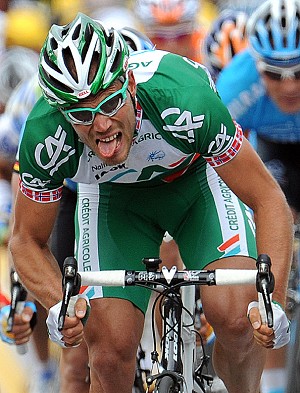The butcher’s bill at the end of the first week of the Tour de France is always heavy. There are claims that the 2011 Tour has been worse than most. In fact, similar things were said about the 1996 and 1997 races, when there were crashes galore, and about the Tours of 2003 and 2004, when there were spectacular pile-ups in finish sprints.
There were cuts and bruises and broken collarbones, but nothing on the scale of the accidents that cost Wouter Weylandt his life in the Giro d’Italia, and left the Colombian Juan Mauricio Soler struggling to recover from an induced coma in a Swiss hospital.

There were others…if the Dutch climber Robert Gesink was struggling here, that could be traced back to his crash on Wednesday. Another sufferer was the Canadian Ryder Hesjedal, seventh in the 2010 Tour, caught up in both the Wiggins crash and the pile-up that cost Alberto Contador over a minute on stage one, and another rider under the weather.
As for a reason, the structure of the first week made the race particularly tense. “It’s been a really nervous first week, there are lots of technical finishes, but they are important because they are uphill, that makes position in the field more critical,” said the American Levi Leipheimer, who finished third in the 2007 Tour and was one of the unfortunates who lost time in this year’s opening stages.
“It’s a long first week, there is nothing separating the riders going for the general classification, the team time trial result was so close and that’s kept everyone nervous. It’s unfortunate that the race is being decided by crashes. They are part of the sport but I don’t know if it’s right having it to this degree.”
Thor Hushovd believes the crashes are the fault of the wind. “The wind makes everyone nervous, they all want to stay in the front,” the
As one rider said, “There are five sprinters’ teams trying to stay in front, and nine teams with overall contenders. That is simply too many even when the roads are wide.”
The former king of the mountains Robert Millar once said that Tour cyclists wear out a set of brake blocks a day and learn to swear in several languages in the opening week of the Tour. On the website cyclingnews.com, Millar wrote this week “crashes are so expected … they even have a classification for crashing, which surprisingly isn’t yet sponsored: chute grave [serious], chute massive [crash with lots of riders involved], chute avec consequence [someone got hurt] and chute sans consequence [someone fell off but it didn’t draw enough blood to worry about].”
Wiggins was flown out of a military airport near Châteauroux on a private flight to Manchester on Saturday and on Sunday he will have an operation on his broken left collarbone to insert a plate.
The fracture is clean and, while the plate will remain in place for up to two years, most cyclists with similar injuries may resume training on a home trainer after five days, returning to the road after 10 days.
There is speculation that Wiggins may ride in the Tour of Spain in order to prepare for the world road time trial championship in Denmark at the end of September.
The Vuelta a España starts on 20 August and there is speculation that a comeback race for the triple Olympic gold medallist could be the Tour of Denmark from 3-7 August.
by Terence Johns

